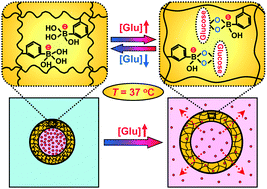Microfluidic fabrication of monodisperse microcapsules for glucose-response at physiological temperature†
Abstract
Hydrogel-based hollow microcapsules with good monodispersity and repeated

* Corresponding authors
a
School of Chemical Engineering, Sichuan University, Chengdu, Sichuan 610065, P. R. China
E-mail:
chuly@scu.edu.cn, wangwei512@scu.edu.cn
Fax: +86 28 8546 0682
Tel: +86 28 8546 0682
Hydrogel-based hollow microcapsules with good monodispersity and repeated

 Please wait while we load your content...
Something went wrong. Try again?
Please wait while we load your content...
Something went wrong. Try again?
M. Zhang, W. Wang, R. Xie, X. Ju, L. Liu, Y. Gu and L. Chu, Soft Matter, 2013, 9, 4150 DOI: 10.1039/C3SM00066D
To request permission to reproduce material from this article, please go to the Copyright Clearance Center request page.
If you are an author contributing to an RSC publication, you do not need to request permission provided correct acknowledgement is given.
If you are the author of this article, you do not need to request permission to reproduce figures and diagrams provided correct acknowledgement is given. If you want to reproduce the whole article in a third-party publication (excluding your thesis/dissertation for which permission is not required) please go to the Copyright Clearance Center request page.
Read more about how to correctly acknowledge RSC content.
 Fetching data from CrossRef.
Fetching data from CrossRef.
This may take some time to load.
Loading related content
